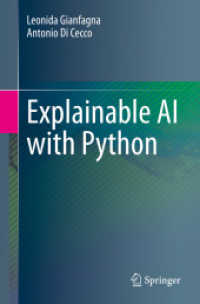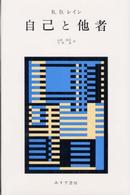- ホーム
- > 洋書
- > 英文書
- > Literary Criticism
Full Description
Between the waning of the Renaissance and the beginning of the Enlightenment, many fundamental aspects of human behaviour - from expressions of gender to the experience of time - underwent radical changes. While some of these transformations were recorded in words, others have survived in non-verbal cultural media, notably the visual arts, poetry, theatre, music, and dance. Structures of Feeling in Seventeenth-Century Cultural Expression explores how artists made use of these various cultural forms to grapple with human values in the increasingly heterodox world of the 1600s.
Essays from prominent historians, musicologists, and art critics examine methods of non-verbal cultural expression through the broad themes of time, motion, the body, and global relations. Together, they show that seventeenth-century cultural expression was more than just an embryonic stage within Western artistic development. Instead, the contributors argue that this period marks some of the most profound changes in European subjectivities.
Contents
Acknowledgments viii
List of Illustrations ix
Notes on Contributors xi
Introduction: On Bodies, Affects, and Cultural Identities in the Seventeenth Century 1
SUSAN McCLARY (University of California Los Angeles, Musicology)
I The Science of Affect
1 Disciplining Feeling: The Seventeenth-Century Idea of a Mathematical Theory of the Emotions
DANIEL GARBER (Princeton University, Philosophy)
2 Clockwork or Musical Instrument? Some English Theories of Mind-Body Interaction Before and After Descartes
PENELOPE GOUK (University of Manchester, History)
3 The Sound World of Father Mersenne
THOMAS CHRISTENSEN (University of Chicago, Music)
II Colonial Extensions
4 Transforming Amerindian "Savages" into Civilized French Catholics: The Art of "Voluntary Subjugation" as the French Colonial Ideal
SARA MELZER (University of California Los Angeles, French and Francophone Studies)
5 Fear of Singing
GARY TOMLINSON (Yale University, Music)
6 The Illicit Voice of Prophecy
OLIVIA BLOECHL (University of California Los Angeles, Musicology)
III The Politics of Opera
7 Daphne's Dilemma: Desire as Metamorphosis in Early Modern Opera
WENDY HELLER (Princeton University, Music)
8. A Viceroy Behind the Scenes: Opera, Production, Politics, and Financing in 1680s Naples
LOUISE STEIN (University of Michigan, Musicology)
IV Baroque Bodies
9 Crashaw and the Metaphysical Shudder; Or, How to Do Things with Tears
RICHARD RAMBUSS (Emory University, English)
10 Cutting, Branding, Whipping, Burning: The Performance of Judicial Wounding in Early Modern England
SARAH COVINGTON (Queens College of the City University of New York, History)
11 Excursions to See Monsters: Odd Bodies and Itineraries of Knowledge in the Seventeenth Century
KATHRYN HOFFMAN (Northwestern University, Anthropology)
V Toward a History of Time and Subjectivity
12 Temporality and Ideology: Qualities of Motion in Seventeenth-Century French Music
SUSAN McCLARY (University of California Los Angeles, Musicology)
13 Temporal Interventions: Music, Modernity and the Presentation of the Self
RICHARD LEPPERT (University of Minnesota, Cultural Studies and Comparative Literature)
Index







